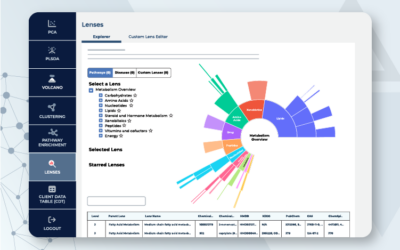In conjunction with cholesterol and glycerophospholipids, sphingolipids play a key role in the membranes of eukaryotic cells.1 Cellular apoptosis, proliferation, and differentiation are modulated by sphingolipid metabolites.2 Sphingolipids include ceramide, ceramide-1-phosphate (C1P), sphingosine, sphingomyelin (SM), and sphingosine-1-phosphate (S1P).3
Deviations in sphingolipid metabolism can cause an array of disorders.1 Thus, the study of sphingolipids correlating to infectious disease offers insights into disease states and their pathogenesis, such as pathogen receptors and impacting host defense.4-6 The relationship between sphingolipids and inflammation contributes to several disease states.3
Sphingolipids Correlate to Inflammation
Ceramide, the parent compound of sphingolipids, activates inflammation, such as neuroinflammation, when it accumulates.3,7 Further, research shows S1P’s role in driving inflammation, as S1P prompts increased p38MAPK and JNK/SPAK activation and promotes inflammatory mediators.8 Data indicates vascular inflammation may be impacted due to the proinflammatory signaling pathways induced by S1P.8 In addition, studies document C1P and S1P as contributing to intestinal inflammation post-abdominal surgery.8
Due to their role in regard to regulating inflammation response, sphingolipids impact conditions like asthma, inflammatory bowel disease (IBD), and cystic fibrosis (CF).8
Leveraging Sphingolipids to Understand Disease States
Studies note sphingolipids’ impact on inflammation in asthma due to an ORMDL3 gene deficiency.9,10 In particular, S1P regulates cell response extra- and intracellularly through calcium mobilization.11,12
Further, sphingolipids impact the proinflammatory response in IBD due to mutations in IL-6.13 For example, increased ceramide and SM levels correlated with chronic colitis and Crohn’s disease.3
In addition, research documents the connection between sphingolipids and cancer. In particular, derivatives from the ceramide and S1P ratios impact the regulation of cancer cell survival and death.14
Obesity, fatty liver disease, and insulin resistance are all impacted by sphingolipids, notably sphingosine and ceramide.3 Elevated levels of ceramide correlate with the reduced ability for glycogen synthesis and glucose uptake.15
Moreover, studies note variations in sphingolipid composition are connected to neurodegenerative diseases, such as Alzheimer’s disease and Parkinson’s disease.3 For instance, accumulation of sphingolipids occurs with aggregation of the Parkinson’s disease marker, alpha-synuclein (α-syn).3
Sphingolipids are also implicated in lysosomal storage disorders. Studies document their role in Gaucher’s disease, Niemann–Pick disease, and gangliosidoses.3
Implications of Sphingolipids for Disease State Research
Given the growing body of research documenting the implications of sphingolipids on an array of disease states, researchers can turn to sphingolipid assays to inform their research for viable, efficacious treatments. Studies suggest the potential for substrate reduction, gene therapies, or enzyme replacement to potentially correct deviations in homeostasis.3
With Metabolon’s growing metabolite reference library and validated panels, we are excited to contribute to your sphingolipid research, helping you gain insights more quickly and ultimately get closer to understanding and combating many major diseases. Sphingolipid analysis is a fast-growing field of exploratory research, and we will continue to share our insights along with new research as discoveries are made.
Ready to see what new insights sphingolipids can help your research reveal?
Contact us today to discuss your project or study.
References
- Kolter T, and Sandhoff K. “Sphingolipid metabolism diseases.” Biochimica et Biophysica Acta (BBA) – Biomembranes. 2006; 1758(12): 2057-2079. https://doi.org/10.1016/j.bbamem.2006.05.027.
- Hanada K. Sphingolipids in infectious diseases. Japanese journal of infectious diseases. 2005;58(3):131.
- Quinville BM, Deschenes NM, Ryckman AE, Walia JS. A Comprehensive Review: Sphingolipid Metabolism and Implications of Disruption in Sphingolipid Homeostasis. Int J Mol Sci. 2021;22(11):5793. doi: 10.3390/ijms22115793.
- Markwell MA, Svennerholm L, Paulson JC. “Specific gangliosides function as host cell receptors for Sendai virus.” Proc. Natl. Acad. Sci. U. S. A.. 1981; 78:5406-5410. https://doi.org/10.1073/pnas.78.9.5406
- Karlsson KA. Animal glycosphingolipids as membrane attachment sites for bacteria. Annual review of biochemistry. 1989; 58(1):309-50.
- Sandvig K, van Deurs B. “Transport of protein toxins into cells: pathways used by ricin, cholera toxin Shiga toxin.” FEBS Lett. 2022; 529: 49-53.
- De Wit NM, Den Hoedt S, Martinez-Martinez P, Rozemuller AJ, Mulder MT, De Vries HE. Astrocytic Ceramide as Possible Indicator of Neuroinflammation. J. Neuroinflamm. 2019;16:48. doi: 10.1186/s12974-019-1436-1.
- Yogi A, Callera GE, Aranha AB, Antunes TT, Graham D, Mcbride M, Dominiczak A, Touyz RM. Sphingosine-1-Phosphate-Induced Inflammation Involves Receptor Tyrosine Kinase Transactivation in Vascular Cells Upregulation in Hypertension. Hypertension. 2011. doi: 10.1161/HYPERTENSIONAHA.110.162719.
- Ammit AJ, Hastie AT, Edsall LC, Hoffman RK, Amrani Y, Krymskaya VP, Kane SA, Peters SP, Penn RB, Spiegel S, et al. Sphingosine 1-Phosphate Modulates Human Airway Smooth Muscle Cell Functions That Promote Inflammation and Airway Remodeling in Asthma. FASEB J. Off. Publ. Fed. Am. Soc. Exp. Biol. 2001;15:1212–1214. doi: 10.1096/fj.00-0742fje.
- Jolly PS, Rosenfeldt HM, Milstien S, Spiegel S. The Roles of Sphingosine-1-Phosphate in Asthma. Mol. Immunol. 2002;38:1239–1245. doi: 10.1016/S0161-5890(02)00070-6.
- Hong Choi O., Kim JH., Kinet JP. Calcium Mobilization via Sphingosine Kinase in Signalling by the FcɛRI Antigen Receptor. Nature. 1996;380:634–636. doi: 10.1038/380634a0.
- Prieschl EE, Csonga R, Novotny V, Kikuchi GE, Baumruker T. The Balance between Sphingosine and Sphingosine-1-Phosphate Is Decisive for Mast Cell Activation after Fc Epsilon Receptor I Triggering. J. Exp. Med. 1999;190:1–8. doi: 10.1084/jem.190.1.1.
- Mitselou A, Grammeniatis V, Varouktsi A, Papadatos SS, Katsanos K, Galani V. Proinflammatory Cytokines in Irritable Bowel Syndrome: A Comparison with Inflammatory Bowel Disease. Intest. Res. 2020;18:115–120. doi: 10.5217/ir.2019.00125.
- Ogretmen B. Sphingolipid Metabolism in Cancer Signalling and Therapy. Nat. Rev. Cancer. 2018;18:33–50. doi: 10.1038/nrc.2017.96.
- Holland WL, Knotts TA, Chavez JA, Wang LP, Hoehn KL, Summers SA. Lipid Mediators of Insulin Resistance. Nutr. Rev. 2007;65:S39–S46. doi: 10.1301/nr.2007.jun.S39-S46.





